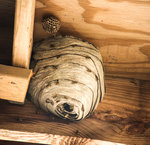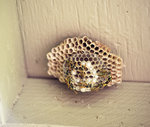

Whether having a picnic or working around the yard, a common summertime nuisance are the stinging insects that show up.
There are three members of the insect family Vespidae that are common in the Pacific Northwest — paper wasps, yellow jacket wasps and hornets.
This family of insects are considered eusocial wasps, which means they live in communities of fertile queens and infertile workers. The adult wasps construct gray or brown, papery nests made from the fibers of tree bark and plant stems. The nests are often hidden under or inside structures like house eaves, fence rails, porch furniture, bird houses, windowsills and light fixtures.
Members of the Vespidae family are often referred to interchangeably, but they have different characteristics around your property.
A paper wasp is slender and about five-eighths of an inch long, and sports yellow and black stripes on its torso. The nest of the paper wasp is probably the most familiar sight, with its exposed hexagonal cells clustered into a single cone and suspended by a narrow stalk. These nests are often occupied by multiple paper wasps, which may number in the dozens or hundreds in late summer.
Paper wasps are beneficial predators who prey on other insects, particularly caterpillars, who feed on plants. But paper wasps will defend their nest from intruders, including humans, who come too close, and this makes them unwelcome around most households.
Management of paper wasps depends upon the season. In mid-autumn, the fertilized, mature females leave their colony to overwinter in warm, sheltered areas such as attics, garages and basements. Maintaining door and window screens and caulking holes in walls or siding can prevent them from accessing these areas.
In April and May, a surviving queen wasp will create a new nest or “pirate” an existing nest, where she will deposit her eggs. These nests can be removed by knocking them down with a long broom, pole or stream of water from a hose. This is the best time to remove a nest because only the single female will be guarding it.
During late spring and early summer, adult wasps forage for immature grubs, caterpillars and other insects. No control is needed, since these wasps rarely sting while foraging.
By late summer and early autumn, nests may have grown quite large and multiple wasps may “guard” the nest, so physical nest removal is more hazardous. Unwanted paper wasps and their nests can be sprayed with an insecticide, which is often designed to shoot a long stream from an aerosol can and can reach the nest from a relatively safe distance. For best control, spray the nests early in the morning or late in the evening when the adult wasps are on the nest, and are fairly inactive.
Yellow jacket wasps share the yellow and black striping of the paper wasp, but are only about one-half-inch long and are more compact. Yellow jacket wasps are also beneficial predators, but they are far more aggressive toward humans and will mass attack intruders that threaten the nest.
Yellow jacket wasps will also invade your picnic, scavenging for sweet substances and protein sources. They are a common nuisance in garbage areas and on ripening berry and tree fruits as well.
Yellow jacket wasps often nest underground, and can be located by the “activity at the airport” that they generate flying in and out. A colony may contain thousands of yellow jackets by late summer. They are easily provoked and will aggressively defend their nest from intruders, often chasing the perceived threat for large distances. What’s more, they can sting multiple times, making them a real threat. Sounds and vibrations, such as a lawn mower, can trigger an attack even from a distance.
Ground nests can be controlled with a single application of an insecticidal dust directed at the nest opening. This contaminates the entire nest, and the wasps will die off within a day or two. Early morning is the safest time for treatment, since the yellowjackets will be in their nest and less active. Leave the nest open so the wasps can continue to enter and leave.
Some recommend strolling by in a nonchalant manner to apply the dust and then retreating with haste, believing that the wasps can sense “bad intent.”
The nest of the hornet is an oval shaped sphere that resembles wrapped layers of paper. It has a single entrance to multiple combs within, and may grow to several thousand insects later in summer. The nest is usually tucked into sheltered areas such as the eaves of buildings, or may hang from trees or branches.
Hornets will aggressively defend their nest and will attack en masse if an intruder threatens the nest site. Removal of the nest is often best handled by a professional wearing protective attire.
Members of the Vespidae family die out over the winter, leaving only a fertile queen to shelter over winter and create a new colony in the spring. If their nests are in a location where they pose no threat to humans, there is no harm in leaving them intact.